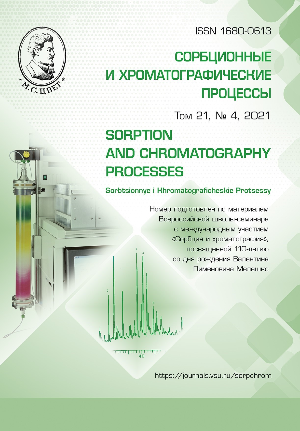The determination of high-boiling organic compounds using block-porous sorption systems
Abstract
The determination of trace amounts of toxic substances in atmospheric air (with a concentration of 0.1-0.5 mg/m3) is hindered during the stage of concentration, which is one of the main sources of error. Concentration is carried out using sorbents of different natures. The block material with variable porosity developed at Samara University (formerly Kuibyshev Aviation Institute) has advantages over other sorbents due to the possibility to pass large volumes of air through it and due to the simple desorption process.
The aim of the work was to study the possibility of using a block material with a variable porosity as a foundation for a sorption system designed to concentrate high-boiling organic compounds.
Х18Н10Т steel was used to manufacture experimental samples. The process of samples production included the stages of forming base blocks and etching samples in hydrochloric acid followed by their oxidation at temperatures of 350, 500, and 750°C (the colour of the surface became darker: the higher the temperature, the darker the colour). The study of the obtained samples was carried out using the example of identifying a high-boiling compound, dioctylphthalate (DOP). To study the obtained samples, as well as to evaluate and compare the absorption (the concentration system of an absorber with isopropyl alcohol) and adsorption (the concentration system of a silicone tube with a sample of the sorption system) concentration, an installation was assembled used to produce gas flows with trace amounts of DOP in the air. The quantitative analysis of the obtained concentrates was conducted by gas chromatography.
As a result of the quantitative analysis of the DOP extract in isopropyl alcohol (IPA) obtained by absorption concentration, the approximate concentration of DOP in the gas phase was determined C=0.46 ±0.15 mg/m3. It was found that the smallest amount of DOP was desorbed from the untreated sample. This is due to the fact that this sample practically did not have a highly developed adsorption layer. The amount of DOP desorbed from samples treated at different temperatures differed insignificantly. As part of the work, a comparative assessment of various concentration methods was carried out. It was found that the standardised method to determine DOP with absorption concentration provided clearly underestimated results in comparison to the adsorption concentration. This may be explained by both the incomplete capture of DOP in the gas flow and the introduction of additional errors due to extract evaporation. Adsorption concentration using activated carbon also provided an underestimated result. DOP desorption from activated carbon was carried out similar to the obtained experimental samples. The underestimated result may be associated with incomplete DOP desorption from activated carbon. Thus, using the proposed systems allows increasing not only the accuracy of DOP determination due to the more efficient capture of the component but also the precision of the analysis.
Downloads
References
Igolkin A.A., Safin A.I., Shakhmatov E.V., Shipbuilding, 2012, Vol. 8, No 4, pp. 46-48.
Safin A.I., Igolkin A.A., Shakhmatov E.V., Vector of Science of TSU, 2013, No 2, pp. 200-202.
Tupikova E.N. Diss. cand. chem. nauk. Samara, 2003, 153 p.
Fedorov A.A., Kaziev G.Z., Kazakova G.D. Methods for chemical analysis of natu-ral environment objects. Moscow, KolosS, 2013, 118 p.
Mark. D., Robertson D.J., J. Air Pollut. Control. Assoc, 1990, Vol. 30, pp. 261-267.
Drugov Yu.S., Rodin A.A. Gas chroma-tographic analysis of polluted air. M., Bi-nom. Knowledge laboratory, 2015, 531 p.
Platonov I.A., Kolesnichenko I.N., Novikova E.A., Sorptsionnye I Khromato-graficheskiye protsessy, 2017, Vol. 17, No 3, pp. 378-387.
Platonov I.A., Rodinkov O.V., Gorba-cheva A.R., Journal of Analytical Chemistry, 2018, Vol. 73, pp. 109-127.
MUK 4.1.3168-14. M.: Federal Center for Hygiene and Epidemiology of Rospo-trebnadzor, 2015, 30 p.
MU 5222-90. M. 1990, 15 p







